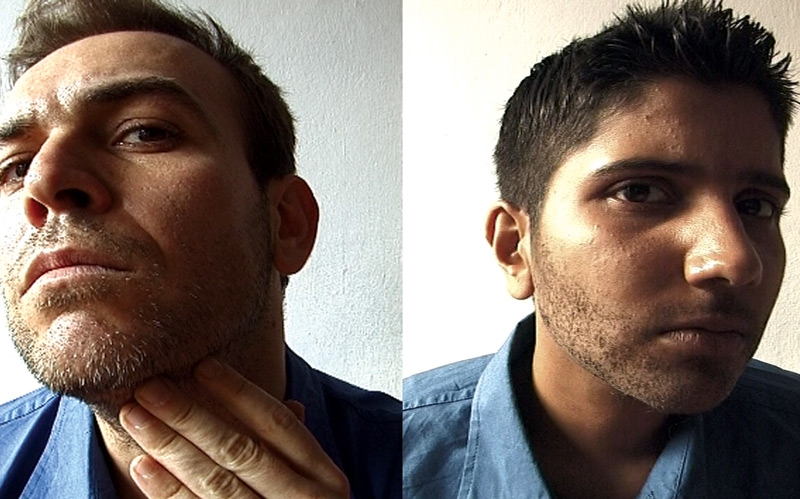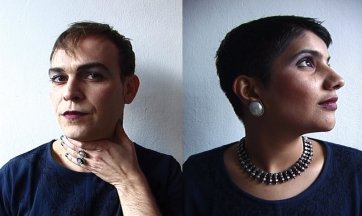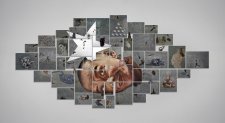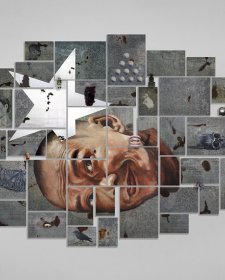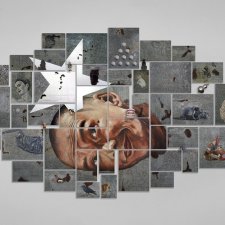Informed by a range of sources from different hirstories, including stories from various disenfranchised subcultures, her work both references and transcends otherness. Her practice continues to remain research based and self-reflexive.
Shah’s works have been exhibited in museums, galleries and film festivals internationally. She was the recipient of the Sanskriti Award in 2009. In 2003–04, she co-founded, organised and curated Larzish – India’s premier International Film Festival of Sexuality and Gender Plurality. She holds a BA in photography from RMIT, Melbourne and has been an Exchange Scholar at the Art Institute of Chicago. Currently, Tejal works out of her laptop and Bombay city.
There is a prefix living between us
A prefix is termed ‘a performative’ because it amends the structure of the word to which it is attached. The term prefix best describes Tejal Shah’s practice; consequently, of the lot, the prefix ‘trans’ is its most pithy descriptor. In its capacity as prefix, trans is committed to flux, movement, exchange, hybridity and such like; it is by any measure a queer word. By titling her 2004–05, video work Trans- the artist invokes the compelling character of words such as transform, transfix, transit, translate, transgender, transfer, transient, transgressive, transvestite, transnational, transliterate.
The performative edge of Tejal’s projects alters, mutates even, original compositions. An early video, I Love My India 2003, is a hypnotic dissection of religion, nationalism, and communalism. In it a balloon-targetshooting stall becomeseerie when the balloons are laid out to read ‘I ♥ India’. Encounter(s) 2006, in collaboration with Varsha Nair, is an elegant inquiry into the aloneness engendered by the urban hullabaloo. For the performance, modified straightjackets connected the two performers as they acclimatised to their surroundings. With Trans-, in collaboration with Marco Paulo Rolla, it could be suggested that the prefix is recognised, albeit subliminally, as metaphor and conceptual tool.
Throughout the twelve-minute video, we only get to see the artists’ torsos. It is as though they’re readying for mugshots to be made for the ostensible gender transgressions they’re performing; their uniform attire alerts us to the same. From stern blue-collar shirts to lightly embroidered black shirts and from shaving to makeup; during the course of the video the artists perform rituals associated with both genders. They employ queer performativity to undermine straight performativity ingrained in heteronormative cultures. In the preceding sentence ‘straight’ replaces the more commonly used term ‘gender’ in a bid to put forward a less blinkered understanding of Tejal’s artistic projects.
It would be all too easy, and obvious, to ‘complete’ the title by reading transgender or transvestite into it. It would also be grossly unfair, and perhaps even impossible, to curtail the video strictly to the gender arena. Yes, Tejal delights in smudging gender binaries and vanities but the open-ended and hyphenated title recalls gateways of possibilities that look beyond arterial roads, and instead open onto back alleys, dimly lit foyers, challenging cul-de-sacs and such like. Tejal is cognisant of the politics in which art is anchored. In making a case for hybridity and cross-pollination she overcomes whatever fatigue might be attached to subjects like gender and portraiture.
Despite its performativity Tejal’s practice is, more often than not, acutely intimate. In fact, we witness this intimacy being performed in her projects. The intimacy is occasioned by an absence of strident agenda making. In a more recent work, evocatively titled There is a spider living between us 2008, she makes a fuckton of desire legible; working with a variety of media from animation to collage to drawing, the artist eventually spins it all together in a single channel video. From questioning desire to exploring networks of Jungian complexes, in the video the seductive and dangerous spider – a metaphor for desire – plays the part of a prefix. Despite all its political connotations, this writer would like to think that the mugshot format selfportrait was chosen because it too lends itself to a certain intimacy.
In Trans-, the artists revel in their transgressions. In the face of the authoritative camera they pull their best subversive faces. A strategy Jean Genet would no doubt approve of. Genet’s A song of love (Un chant d’amour ) 1950, the only film directed by the French writer and provocateur, is set in a prison, where a voyeuristic and jealous prison guard tries to unsuccessfully hinder the attraction between two male prisoners. In our viewing ofTrans-, as the two mugshot candidates pass through the blender, we take up a voyeuristic position reminiscent of the guard’s. We are tantalised by the artists’ performance. They interrupt us. We want to interrupt them. Be that as it may, the video and the film are antagonistic without being abrasive.
As I bring this essay to a wrap, two years ago on this same day in a historic judgement, Section 377 of the Indian Penal Code was read down to decriminalise same-sex behaviour among consenting adults. In Tejal’s various bodies of work there are no illusions about harmony; should this have been the case, saturated rainbows would’ve taken over her world. In order to keep the practice alive, antagonism is cherished as a necessity.
Gitanjali Dang
Independent curator-critic, Bombay
